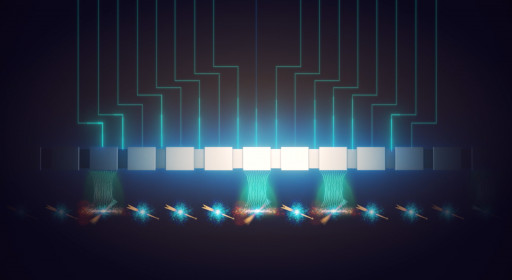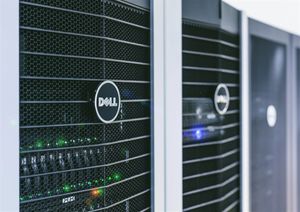Quantum Computer With Billions of Qubits Closer After New Spin Control Method Discovered

Multiple qubits being controlled by the new technique
Illustration of how multiple qubits could be controlled using the new 'intrinsic spin-orbit EDSR' process discovered by Diraq [Tony Melov]
Engineers have discovered a new way of precisely controlling single electrons in quantum dots that run logic gates. What's more, the new technique is less bulky and needs fewer parts - essential to making large-scale silicon quantum computers a reality. The discovery, made by engineers at the quantum computing startup Diraq, is in the journal Nature Nanotechnology.
"This was a completely new effect we'd never seen before," said lead author Dr. Will Gilbert, an engineer at Diraq, a UNSW spin-off based at the university's Sydney campus, Australia. "But it quickly became clear that this was a powerful new way of controlling spins in a quantum dot. And that was super exciting."
Logic gates are the basic building block of all computation; they allow 'bits' - or binary digits (0s and 1s) - to work together to process information. However, a quantum bit (or qubit) exists in both of these states at once, known as a 'superposition'. This allows a multitude of computation strategies - some exponentially faster, some simultaneous - that are beyond classical computers. Qubits themselves are made up of 'quantum dots', tiny nanodevices that can trap one or a few electrons. Precise control of the electrons is necessary for computation to occur.
While experimenting with different geometrical combinations of devices just billionths of a meter in size that control quantum dots, and various types of miniscule magnets and antennas that drive their operations, Dr. Tuomo Tanttu stumbled across a strange effect.
"I was trying to really accurately operate a two-qubit gate, iterating through a lot of different devices and slightly different geometries," recalls Dr. Tanttu, an engineer at Diraq. "Then this strange peak popped up. It looked like the rate of rotation for one of the qubits was speeding up, which I'd never seen before."
What he had discovered, the engineers later realised, was a new way of manipulating the quantum state of a single qubit by using electric fields, rather than the magnetic fields used previously. Since the discovery in 2020, Diraq has been perfecting the technique - which has become another tool in their arsenal to fulfil Diraq's ambition of building billions of qubits on a single chip.
"This is a new way to manipulate qubits, and it's less bulky to build - you don't need to fabricate cobalt micro-magnets or an antenna right next to the qubits to generate the control effect," said Gilbert. "There's less clutter."
"This is a gem of new mechanism, which just adds to the trove of proprietary technology we've developed over the past 20 years of research," said Prof Andrew Dzurak, CEO and Founder of Diraq, and Professor in Quantum Engineering at UNSW, who led the team that built the the first quantum logic gate in silicon in 2015.
"It builds on our work to make quantum computing in silicon a reality, based on essentially the same semiconductor component technology as existing computer chips, rather than relying on exotic materials," he added. "Since it is based on the same CMOS technology as today's computer industry, our approach will make it easier and faster to scale up for commercial production and achieve our goal of fabricating billions of qubits on a single chip."
LINKS FOR MEDIA USE ONLY
Contact Information:
Prof Andrew Dzurak
CEO & Founder, Diraq; and Professor in Quantum Engineering, UNSW
andrew@diraq.com
+61 432 405 434
Dr Tuomo Tanttu
Senior Measurement Engineer, Diraq
tuomo@diraq.com
+61 401 517 972
Wilson da Silva
Media Advisor, Diraq
media@diraq.com
+61 407 907 017
Dr Will Gilbert
CMOS Design and Measurement Engineer
will@diraq.com
+61 432 235 937
Press Release Service by Newswire.com
Original Source: Quantum Computer With Billions of Qubits Closer After New Spin Control Method Discovered
More News
View More




Recent Quotes
View More
Quotes delayed at least 20 minutes.
By accessing this page, you agree to the Privacy Policy and Terms Of Service.